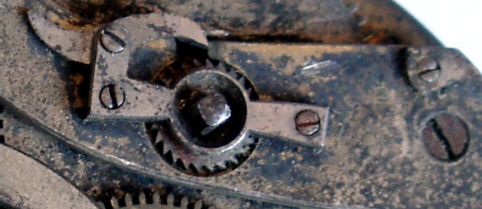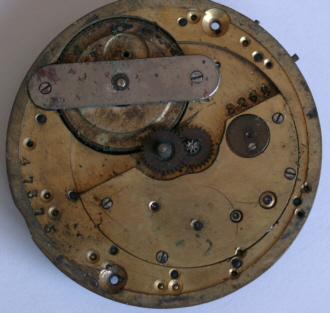
| WWT Shows | CLICK TO: Join and Support Internet Horology Club 185™ | IHC185™ Forums |

|
• Check Out Our... • • TWO Book Offer! • |
Welcome Aboard IHC185™  Internet Horology Club 185
Internet Horology Club 185  IHC185™ Discussion Site Main Page
IHC185™ Discussion Site Main Page  Horological Discussions, Questions and Answers
Horological Discussions, Questions and Answers  European Pocket Watch Forum
European Pocket Watch Forum  How does this work?
How does this work?
 Internet Horology Club 185
Internet Horology Club 185  IHC185™ Discussion Site Main Page
IHC185™ Discussion Site Main Page  Horological Discussions, Questions and Answers
Horological Discussions, Questions and Answers  European Pocket Watch Forum
European Pocket Watch Forum  How does this work?
How does this work?Go  | New Topic  | Find-Or-Search  | Notify  | Tools  | Reply to Post  |  |
This movement came from my junk box. To me it looks like something a bit better and I was hoping somebody can tell me about it. It has 15 jewels I can see. The regulator assy appears fairly complex and is unlike anything I can find in my books. There appears to be some kind of a quadrant that is attached to the end of the regulator arm. The other end of the quadrent under the arm has the slot for the hair spring. looks to be a solid balance with no splits.  | |||
|
Here is a close up of the escape area. Note the extra bit attached to the top of the balance bridge. The regulator arm is shaped to lie flat on the bridge and has a slot to clear this extra part. There appears to be no reason for this arrangement apart from decoration.  | ||||
|
Even the mainspring ratchet is more complex than needs be. There was a long flat spring that acted on it. The remains of the spring are still there. A tiny ear is provided for the spring to contact with. The ratchet wheel is set below the plate and there is an extension to the ratchet lever underneath to connect with the teeth.  | ||||
|
The main plate is actually made from 3 parts. with a number of screws holding everything together. 2 of the plates carry number but they do not match. The main or outer plate is numbered 47375 and is about 45mm Dia. The second or inner plate is about 36mm dia and carries a number of 8268. The third bit has the jewels and does not appear to be marked. Is this movement worthy of restoration or should I return it from whence it came.  | ||||
|
The unusual apparatus supporting the upper balance jewel is called a "parachute" and is an early form of shock resist. It was invented by Breguet. You will also note the double arc of metal extending out from the end of the regulator where the regulator pins are. This is a compensation curb that changes the distance between the regulator pins with changes in temperature -- a form of temperature compensation. I have seen both of these features on a number of mid-grade Swiss bar movements. Unless you really want a project it is probably just as well to leave this as a study piece in your collection. Without a famous name attributed to this movement it is probably not worth much, even if restored. | ||||
|
Thanks for that. Now that I know there is nothing of great value here I will most likely use the movement to practice my cleaning skills on. | ||||
|
I love these complicated movements, especially when they are not marked, it makes for a good hunt for information. I would love to see it if you clean it. I have a few movements that I have kept, as is, just because I like the movement, and it's unusual parts. Even a mess of a watch is great to me, and when you can get information like that given by Jerry, it makes it even better. Sheila | ||||
|
Stephan, To add to Jerry's excellent explanation of your watch, Breguet's parachute mechanism (actually called Pare-Chute), was invented around 1800 and therefore pre-dates the incabloc type systems we know by nearly One and a Half Centuries! Don't know about you, but I think that's Awesome considering the workshop facilities those guys had way back then ! I personally would reserve judgement regarding value of the watch though - monetary and intrinsic!. I don't know about the US, but certainly in Europe and possibly your neck of the woods, there Will be collectors around that would pay decent money for a movement example bearing a parachute shock resist system,... But! I would add the proviso that it depends upon what one would call 'Worth' They don't appear very often for sale here, and when they do, they don't hang around! Here's my take on the movement anyway ........ but bear in mind I'm a dinosaur that wishes he could hand make watches just like those guys could! It appears to have a mono-metallic balance with timing screws, a counterpoised sidelever escapement (probably with jewel slips in the pallet faces), which together with the temperature compensation gear, jewelling and parachute shock resist system, would have lifted it into a completely different league to some of the stuff available in its era. I can't see the underside of the mainspring barrel too well, but it appears it may also have Geneva stopwork fitted. The additional bar (looks hand made to me)providing a lower bearing for the mainspring barrel is also a feature missed off many 19C pocket watches - particularly cylinder watches, and they were all the worse for it! If you look closer at the plates of the movement, you will find it was actually hand crafted not jig drilled - note the scribe marks made by the depthing tool which marked the jewel hole centres - no fancy machines used there - that's a human touch created by someone physically placing those train wheels in a calliper in order to set out 'by hand' all those jewel and pivot hole centres prior to them being drilled!! In my book at least, it's quite special even if it does look rough, because someone originally spent a lot of time on that creation! I feel your gut reaction that - 'it looks like something a bit better' wasn't actually far off the mark!! For its time and amongst its competition, it probably was! I say study the piece well first, clean it up good and carefully study it whilst you do so, enjoy learning from it and keep it in your collection as a good example of a watch bearing early forms of temperature regulation and shock protection. I doubt you will come across too many other such examples on your travels! I hope you manage to remake broken and missing parts and breathe some life into it again, because the True value of the piece will be in the pleasure you get out of rescuing it! Thanks for posting the thread and photo's! BTW, I have a similar (very highly engraved) example by John Forrest of London, I'll dig it out and post a thread on it at some point. (the watch isn't for sale though .... and I did actually pay a few bob for it! Best regards John | ||||
|
| Powered by Social Strata |
| Your request is being processed... |
|
©2002-2025 Internet Horology Club 185™ - Lindell V. Riddle President - All Rights Reserved Worldwide

